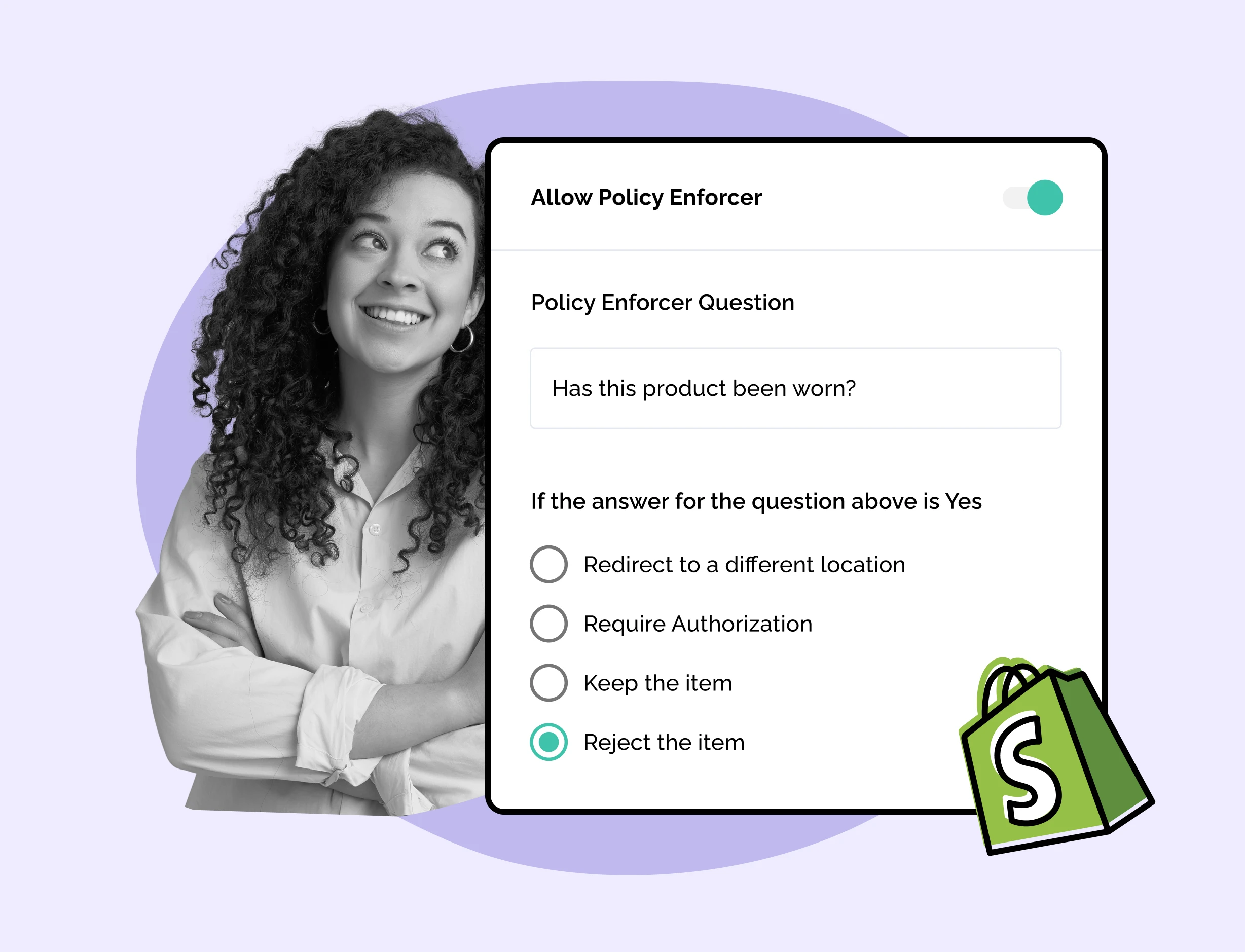
Returns: Customers Keeping Unwanted Products – Bad for Your Brand
Exploring e-commerce returns: Why customers aren’t returning unwanted products and finding the right business balance.
Boost customer experience and reduce support tickets
Realtime order and shipment tracking
Proactive order and shipping notifications
Predictive pre-purchase estimated delivery dates
Self-Serivce branded order tracking
Effortless experience delivered
Make returns profitable and delight customers
Flexibility to define any return destinations & conditions
Simplify returns for your customers and team
Incentivize exchanges over returns
Returns management made easy for your team
Understand why your customers are returning
Unify the online and the in-store experience
Hassle-free pickup experience for customers
In-Store Dashboard to keep operations streamlined
In-Store and Online orders unified
Drive foot-traffic to your stores
Boost customer experience and reduce support tickets
Realtime order and shipment tracking
Proactive order and shipping notifications
Predictive pre-purchase estimated delivery dates
Self-Serivce branded order tracking
Effortless experience delivered
Make returns profitable and delight customers
Flexibility to define any return destinations & conditions
Simplify returns for your customers and team
Incentivize exchanges over returns
Returns management made easy for your team
Understand why your customers are returning
Unify the online and the in-store experience
Hassle-free pickup experience for customers
In-Store Dashboard to keep operations streamlined
In-Store and Online orders unified
Drive foot-traffic to your stores
Find the answer to all your questions
Explore the most comon questions about WeSupply
Calculate the ROI that WeSupply can bring you
Request a no strings attached review of your current shopping experience and missed conversion opportunities
Take a step by step trip through our functionality to see how we can improve your ecommerce processes.
Read actionable articles on how to optimize your post-purchase experience and decrease support tickets
Get inspired by stories of how our customers implemented an effortless post-purchase experience
A Deep Dive into Top Companies' Order Tracking & Returns Strategy
Wondering if WeSupply is a good fit for you? Read through our use cases to see how we can help you increase conversion & improve CX!

In the ever-evolving world of e-commerce, return abuse is a growing concern that threatens the financial stability of online retailers. As return abuse Shopify store owners, it is crucial to stay vigilant and adapt to this emerging challenge. This comprehensive guide explores the complexities of return dynamics, provides strategies for crafting effective return policies, and discusses how to leverage technology and Shopify-specific features to protect your business.
Understand return fraud to protect against costly abuse.
Implement an effective return policy with advanced analytics and verification tools.
Leverage Shopify features & apps, maintain customer trust & loyalty for successful ecommerce stores.
WeSupply offers a streamlined solution to returns management. Eliminate return abuse and lost package issues with real-time tracking. Our system empowers customers to handle returns while you maintain oversight. Combined with our Return Policy Enforcer’s simple eligibility check, we ensure an efficient returns process, enhancing the experience for genuine customers and mitigating unwarranted behavior.
Handling returns in e-commerce strikingly balances excellent customer service with the business’s financial health. Return fraud is a multifaceted issue, with numerous forms and tactics employed by dishonest shoppers to exploit retailers’ return policies for their own gain. With the National Retail Federation estimating that return fraud costs businesses billions of dollars every year, it’s essential to understand the nuances of this problem and how it impacts your Shopify store.
Return fraud presents high stakes for both customers and businesses. For customers, the ease of the return process can be the deciding factor in whether they choose to continue shopping with a particular retailer. For businesses, navigating the intricate web of return requests, fraudulent returns, and customer satisfaction is crucial to maintaining a stable bottom line and staying ahead of potential threats.
The first step to protect your Shopify store from this growing threat is to unravel the mysteries of return dynamics and their implications for online retailers.
The umbrella term ‘return abuse’ encompasses various behaviors like serial returners, returning worn items, or returning counterfeit or stolen items. While some instances of return abuse may involve customers exploiting a retailer’s return policy for personal benefit, return fraud involves deliberately misleading the retailer for financial gain. To complicate matters further, there’s also ‘friendly fraud,’ wherein a customer falsely claims a refund while retaining the merchandise.
The consequences of return abuse for online retailers are immense, with estimates suggesting that it costs merchants up to $15.9 billion annually. Retailers who deal in selling auto parts, apparel, and home improvement products are highly susceptible to fraudulent returns. This devious activity can cost these businesses a lot of money and time. For business success and maintaining customer trust, addressing return abuse is vital since return inspection processes are crucial in identifying and preventing such misconduct.
Return abuse can take many forms, including:
Wardrobing: purchasing an item, using it, and then returning it
Receipt fraud: using counterfeit receipts to return products and request reimbursement
Switching: returning a different item than was originally purchased
Price arbitrage: buying an item on sale and then returning it at full price
Renting: purchasing an item with the intention of returning it after use
Understanding the various types of return abuse enables online retailers to better implement strategies to deter suspicious activity, address it, and protect their businesses from potential financial losses.
The impact of return abuse on e-commerce businesses, especially Shopify store owners, is significant. With an estimated annual cost of $15 billion for US retailers alone, it’s essential to recognize the potential ramifications of return abuse for your business. Financial losses aside, return abuse can also have a detrimental effect on legitimate customers and personnel involved in the returns process, ultimately affecting the overall health of your business.
Adopting proactive prevention strategies and utilizing advanced analytics and verification tools are crucial to safeguard your Shopify store from the growing threat of return abuse. By leveraging technology and implementing effective return policies, you can not only mitigate the risk of return abuse but also ensure a satisfying customer experience for genuine shoppers.
To effectively address each issue and safeguard your Shopify store, understanding the distinctions between return abuse, return fraud, and friendly fraud is necessary. Here are the definitions of each term:
Return abuse: Customers exploiting a retailer’s return policy for personal benefit.
Return fraud: Dishonestly obtaining a refund for items that have not been legitimately purchased or acquired.
Friendly fraud: When a customer seeks a reimbursement based on a false claim, such as alleging that the goods were not received or that the purchase was not made.
Potential indications of fraudulent returns include the absence of a receipt, a modified receipt, items that have been used or damaged, items not in their original packaging, and items that are not the same as the original purchase. In addition to these types of return fraud, retailers should also be aware of cross-retailer return fraud (returning a lower-priced product from a competing retailer to a store in exchange for a higher refund amount), switch fraud (fraudulently swapping components of an order for a refund), and open box fraud (purchasing a high-priced item, returning it, and then buying the same item at a discounted price).
Offering cash refunds can be a significant inducement for customers to perpetrate return fraud. To prevent chargeback fraud, retailers should be explicit in their return policy and provide clear instructions for customers to follow. Understanding the nuances of these different types of return fraud equips you to better tackle each issue and protect your Shopify store.
A well-crafted return policy serves as the first line of defense against return abuse and fraud for your Shopify store. An effective return policy should include definite regulations regarding what is and isn’t permissible, such as a specified period for returns, and should be communicated to customers in a straightforward and succinct way.
To implement an effective return policy, you can utilize a return policy enforcer solution like WeSupply’s Return Policy Enforcer for Shopify store owners. By providing clear guidelines and requirements for returns, you can minimize the risk of return abuse and maintain customer satisfaction.
You can also mitigate return abuse by:
Implementing a time limit on returns
Using a return policy enforcer solution
Providing different return periods for cash refunds and store credit and exchanges.
A comprehensive and well-executed return policy not only deters potential return abuse but also fosters trust and loyalty among your genuine customers.
In return management, advanced analytics and verification tools provide meaningful insights and ensure the accuracy of return processes. Some examples of these tools include:
Machine learning and AI models, which can be employed to analyze customer data and identify patterns
Forecasting tools, which help in predicting customer behavior
Verification tools, which help in preempting potential return abuse
By utilizing these tools, businesses can improve their return management processes and reduce the risk of return abuse.
Reporting tools can be leveraged to monitor key return metrics, such as return rate, return value, and return duration. This data can be utilized to discern trends and make informed decisions regarding return policies. Verification tools are also essential in authenticating returned products by verifying product serial numbers, barcodes, and other identifying information, ensuring that returned products are genuine and not counterfeit.
WeSupply’s technological empowerment in return management revolutionizes eCommerce businesses by employing advanced analytics and verification tools. By deeply understanding customer motivations behind returns, identifying frequently returned products, and recognizing serial returners, businesses can strategically reduce return rates and recover lost revenue. Additionally, integrating insights from extensive data points available in BigQuery enables businesses to optimize processes, products, and return policies, directly enhancing profit margins.
Returns analytics for eCommerce business
Book a quick call with our experts to see how WeSupply’s Return Analytics provides data-driven insights to help eCommerce businesses make decisions about return policies, product mix, and ways to increase revenue.
Store owners can enhance return oversight and management, and ultimately protect their businesses from return abuse by leveraging the features and apps available through the Shopify platform. For instance, Shopify POS offers customers the flexibility to return or exchange an item in store or online, allowing them to be fully satisfied with their purchase.
Utilizing apps such as WeSupply and Refundly can streamline fraud prevention and return management, providing features like automated fraud detection, customer segmentation, and automated return processing. By taking advantage of Shopify-specific features and apps, you can optimize your store’s return management process and minimize the risk of return abuse.
Implementing proactive prevention strategies and utilizing advanced analytics and verification tools are essential to reduce return abuse in your Shopify store. Here are some steps you can take to protect your business:
Establish a clear return policy.
Utilize analytics and verification tools to identify potential fraudulent returns.
Take advantage of Shopify-specific features and apps designed to help prevent return abuse.
By following these steps, you can effectively protect your business from return abuse.
Maintaining consistent and frequent communication with your customers is crucial to keep them apprised of any developments related to returns, such as processing periods or refund statuses. By being proactive and vigilant in addressing return abuse, you can create a more secure and profitable e-commerce environment for your Shopify store.
WeSupply provides an optimized approach to managing returns, resolving issues of return abuse and misplaced packages through real-time returns tracking capabilities. Our platform enables customers to autonomously manage their returns, granting businesses comprehensive supervision. With the integration of our Return Policy Enforcer, which swiftly verifies eligibility, we guarantee a seamless return journey. This process not only elevates the experience for authentic customers but also deters fraudulent activities.
It can be a delicate balancing act to handle suspicious returns while maintaining customer satisfaction and trust. You can address suspicious returns, ensuring that your legitimate customers are not adversely affected, by implementing an effective return policy, employing advanced analytics and verification tools, and utilizing platform features and apps to monitor customer’s account activity
To provide excellent customer service in delicate scenarios, it’s important to ensure that your customer support team is responsive, helpful, and empathetic towards customers’ concerns and inquiries. By addressing suspicious returns in a fair and transparent manner, you can maintain customer trust and loyalty while protecting your Shopify store from potential return abuse.
Thorough examination in the return inspection process is essential for determining the cause of the return, verifying any problems, organizing returns, creating an efficient process, and increasing customer satisfaction. Conducting a comprehensive evaluation in return processes can help to diminish return abuse and fraud, as well as enhance customer satisfaction. However, undertaking a thorough examination of return processes can be costly, as it necessitates the utilization of specialized personnel, equipment, and time, and ensuring accuracy and uniformity in the examination process can prove to be challenging.
To enhance thorough examination in return processes, retailers may want to implement the following tools and features:
Advanced analytics and verification tools, such as machine learning and artificial intelligence
Shopify POS features for employee oversight and return validations
Shopify apps for fraud prevention
These tools and features can help improve the accuracy and efficiency of the return process.
Placing emphasis on thorough examination in return processes can help you better identify and address potential return abuse, safeguard your Shopify store, and ensure the long-term success of your e-commerce business.
WeSupply has a comprehensive return processing flow, which allows personnel to examine and record the condition of the product that was sent back, and only approve or move the return to the next phase if the condition is deemed to be satisfactory
Alternative forms of refunds, such as store credit and partial refunds, can be used to help reduce return abuse rates. Offering store credit, as opposed to a cash refund, can provide customers with an alternative option for reimbursement, which can deter return fraud and motivate them to make future purchases. Store credit is generally more cost-effective for businesses and offers prospects that traditional cash refunds may not possess.
Furthermore, offering partial refunds allows businesses to:
Address customer concerns by providing a partial refund
Minimize the financial cost associated with full refunds
Provide store credit
Enhance customer satisfaction
Mitigate the risk of return abuse
By implementing these strategies, businesses can effectively address customer issues while minimizing financial losses.
WeSupply empowers you to offer partial or full refunds for returns as Store Credit or Gift Cards directly within the returns process, as eligible refund methods. Customers can seamlessly utilize these credits for subsequent purchases in your online platform. Furthermore, this feature allows you to maintain an accurate record of sales and vigilantly oversee items that were previously exchanged.
Incentivize exchanges over returns
Book a quick call with our experts to see how WeSupply can help you save sales through exchanges and boost the average order value using instant store credit.
Maintaining customer satisfaction and trust is crucial, and it involves training and educating your customer support staff to effectively deal with return abuse situations. By providing them with training on how to:
Recognize and prevent fraudulent returns
Detect suspicious behavior
Investigate potential fraud cases
Manage them appropriately
You can better protect your Shopify store from return abuse.
Moreover, to ensure an optimal customer service experience, it is important to ensure that the customer service team is responsive, helpful, and empathetic towards customers’ concerns and inquiries. By investing in the education and training of your customer support staff, you can effectively address return abuse while maintaining a positive relationship with your customers.
To help prevent internal fraud and abuse of the return process, you can utilize Shopify POS features for employee oversight and return validations. By monitoring employee activity, tracking returns, and validating returns, you can ensure that your staff is adhering to your return policies and procedures, minimizing the risk of internal fraud and abuse.
Utilizing Shopify POS features can:
Mitigate the risk of internal fraud and abuse
Enhance the accuracy and expedite the return process
Contribute to a more efficient and secure e-commerce environment for your Shopify store.
Fraud prevention and return management for your Shopify store can be greatly streamlined using top recommended Shopify apps, such as WeSupply and Refundly. These apps offer features like automated fraud detection, customer segmentation, and automated return processing, making it simpler to detect and address dubious returns and providing additional insights into customer behavior.
By taking advantage of these top recommended Shopify apps, you can:
Optimize your store’s return management process
Minimize the risk of return abuse
Protect your business
Ensure the long-term success of your e-commerce enterprise.
While it’s essential to implement stricter return protocols to curtail return abuse, maintaining trust and loyalty among your customers is equally important. Transparency is crucial in building trust, and by providing clear and concise return policies, customers can better understand the process and feel reassured that their concerns are being addressed.
In addition to transparency, offering excellent customer service, publishing customer reviews and testimonials, and implementing incentives and loyalty programs can all contribute to fostering trust and loyalty among your customers. By striking the right balance between implementing stricter return protocols and maintaining strong customer relationships, you can protect your Shopify store from return abuse while ensuring continued customer satisfaction.
With the evolution of e-commerce, ongoing trends and data analysis are prompting businesses to adapt and optimize their strategies, shaping the future of return policies. Some key factors influencing the development of future return policies include:
Machine learning and AI models for predictive analytics
Adoption of data-driven business strategies
Utilization of data insights to optimize inventory, product descriptions, and return policies
These advancements in price switching are helping businesses create more efficient and customer-friendly return policies.
By staying informed about these ongoing trends and incorporating data analysis into your e-commerce strategy, you can better adapt and optimize your return policies to suit the ever-changing landscape of online retail. This will not only help to protect your Shopify store from the growing threat of return abuse but also ensure the long-term success of your e-commerce enterprise.
WeSupply’s analytics optimize return policies through trend analysis, identifying frequent return products, reasons, and serial returners for proactive management.
In conclusion, it’s vital to protect your e-commerce enterprise from the growing threat of return abuse to ensure the long-term success of your Shopify store. Here are some key strategies to consider:
Understand the intricacies of return fraud.
Implement an effective return policy.
Employ advanced analytics and verification tools.
Utilize Shopify-specific features and apps.
Maintain trust and loyalty among your customers.
By following these strategies, you can build a solid foundation for your e-commerce business and safeguard it against the challenges posed by return abuse.
In summary, return abuse is a growing concern for Shopify store owners, and it is essential to take proactive measures to safeguard your e-commerce business. By understanding the complexities of return dynamics, implementing an effective return policy, leveraging technology and Shopify-specific features, and maintaining customer trust and loyalty, you can strengthen your e-commerce enterprise against the growing threat of return abuse and ensure its long-term success.
WeSupply combats Shopify return abuse by integrating real-time tracking and a Return Policy Enforcer, streamlining return management while reducing abuse and package loss. This system prioritizes both business control and customer autonomy, enhancing overall satisfaction. Crucially, WeSupply’s advanced analytics identify core return issues, informing smarter strategies. Furthermore, the platform’s innovative approach offers flexible refund solutions, including store credits or gift cards, encouraging future sales, retaining revenue within the business, and providing customers with seamless, positive experiences.
Shopify enables you to manage returns and refunds, create and send return labels, track returned items, restock inspected goods, and return payments to customers from the Shopify admin.
Yes, returning the wrong item can result in serious repercussions such as fines, penalties, and even jail time depending on the severity of the crime.
Some vendors may charge a fee for items without their tags or returned in opened packaging, while others only offer store credit to ensure the money is still spent in their store. Depending on your company policy, you should explain this to the customer and offer the appropriate option.
Return abuse involves exploiting a store’s return policy, while return fraud involves dishonestly obtaining a refund for items that were not legitimately purchased.
Establish a clear and concise return policy, ensure returns are done within a specified time limit, and utilize a reliable return policy enforcer to maintain consistency.
WeSupply is the best eCommerce Return App for Shopify due to its comprehensive approach to handling returns, enhancing customer satisfaction, and providing actionable insights for businesses.

Learn How To Create Successful Post Purchase Email Campaigns
Build an effective post-purchase email flow that helps you increase customer satisfaction and drive revenue growth!

Exploring e-commerce returns: Why customers aren’t returning unwanted products and finding the right business balance.

In this post, we will explore the paradigm shift in handling product returns and why your brand should accept used returns.

In this article, we’ll explore delivery exceptions, including their causes, prevention, and management strategies.

This post will explore pick and pack ecommerce fulfillment, covering its significance, optimization, challenges, and future trends.

In this comprehensive guide, we’ll delve into the concept of cross-docking and explore its history, benefits, challenges, and best practices.

Discover how safety stock can transform your retail business and prepare you for the future of customer-centric inventory management.

Join us as we explore the what, why, and how of the shift towards carbon neutral shipping in the world of logistics.

In this post, we’ll dive into the world of 4PL logistics, its benefits, challenges, and how it compares to more traditional logistics models.

This article offers a detailed comparison of standard and expedited shipping in e-commerce, helping you make informed logistics choices.